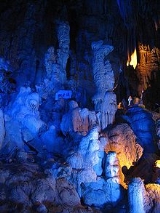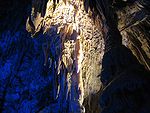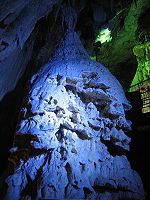
Abukuma-do
Encyclopedia
Abukuma-do is a limestone cave located in Fukushima Prefecture
, Japan
. The cave was discovered on August 15, 1969, northeast of the city of Tamura
and was originally named Kamayama Shonyu-do (釜山鍾乳洞). It was designated a natural heritage of the town on February 7, 1971 and renamed Abukuma-do on June 1, 1973. Visitors can traverse a 600-metre-long path inside the cave as well as a 120-metre-long exploration course to view the stalactite
s and stalagmite
s. Each stalactite has taken more than eighty million years to form. Beyond the public areas lie about 2,500 metres of cave that are not open to the public. Nearby Abukuma Cave is the smaller Irimizu Shonyu-do (入水鍾乳洞 - Irimizu Limestone Cave), discovered in 1927. Irimizu Limestone Cave was designated a National Natural Treasure
on December 28, 1934. The temperature inside Abukuma-do is around 15°C and the humidity is above 90%.
 A notable feature of Abukuma-do is the existence of boxwork
A notable feature of Abukuma-do is the existence of boxwork
, a rare cave formation composed of thin blades of the mineral calcite
that project from cave walls and ceilings, forming a honeycomb or box-like pattern. Boxwork can also be found in Shimukugama in Okinawa
and Sugawatari-do (氷渡洞 - Ice Cross Cave) in Iwate Prefecture
, but because Abukuma-do is currently the only limestone cave in Japan open to tourists, it is subsequently the only cave in Japan in which you can see boxwork.
 The Christmas Tree and the Silver Frost are two of the most distinctive Speleothem
The Christmas Tree and the Silver Frost are two of the most distinctive Speleothem
inside Abukuma-do. The Christmas Tree is a stalagmite and The Silver Frost meets dripstones
on the roof of the cave resulting in an impressive column. Both represent a featured stop along the 600 meter course inside the cave. According to the Abukuma Caves Management Office, The Christmas Tree, at over two metres high, is said to be the largest stalagmite in the East
.
Fukushima Prefecture
is a prefecture of Japan located in the Tōhoku region on the island of Honshu. The capital is the city of Fukushima.-History:Until the Meiji Restoration, the area of Fukushima prefecture was known as Mutsu Province....
, Japan
Japan
Japan is an island nation in East Asia. Located in the Pacific Ocean, it lies to the east of the Sea of Japan, China, North Korea, South Korea and Russia, stretching from the Sea of Okhotsk in the north to the East China Sea and Taiwan in the south...
. The cave was discovered on August 15, 1969, northeast of the city of Tamura
Tamura, Fukushima
is a city located in Fukushima, Japan. The city was founded on March 1, 2005 from the merger of the former towns of Funehiki, Ōgoe, Takine, and Tokiwa and the former village of Miyakoji, all from Tamura District....
and was originally named Kamayama Shonyu-do (釜山鍾乳洞). It was designated a natural heritage of the town on February 7, 1971 and renamed Abukuma-do on June 1, 1973. Visitors can traverse a 600-metre-long path inside the cave as well as a 120-metre-long exploration course to view the stalactite
Stalactite
A stalactite , "to drip", and meaning "that which drips") is a type of speleothem that hangs from the ceiling of limestone caves. It is a type of dripstone...
s and stalagmite
Stalagmite
A stalagmite is a type of speleothem that rises from the floor of a limestone cave due to the dripping of mineralized solutions and the deposition of calcium carbonate. This stalagmite formation occurs only under certain pH conditions within the underground cavern. The corresponding formation on...
s. Each stalactite has taken more than eighty million years to form. Beyond the public areas lie about 2,500 metres of cave that are not open to the public. Nearby Abukuma Cave is the smaller Irimizu Shonyu-do (入水鍾乳洞 - Irimizu Limestone Cave), discovered in 1927. Irimizu Limestone Cave was designated a National Natural Treasure
National treasures of Japan
National Treasures are the most precious of Japan's Tangible Cultural Properties, as determined and designated by the Agency for Cultural Affairs...
on December 28, 1934. The temperature inside Abukuma-do is around 15°C and the humidity is above 90%.
Boxwork

Boxwork
Boxwork is an uncommon type of mineral structure, or speleogen , occasionally found in caves and erosive environments....
, a rare cave formation composed of thin blades of the mineral calcite
Calcite
Calcite is a carbonate mineral and the most stable polymorph of calcium carbonate . The other polymorphs are the minerals aragonite and vaterite. Aragonite will change to calcite at 380-470°C, and vaterite is even less stable.-Properties:...
that project from cave walls and ceilings, forming a honeycomb or box-like pattern. Boxwork can also be found in Shimukugama in Okinawa
Okinawa Prefecture
is one of Japan's southern prefectures. It consists of hundreds of the Ryukyu Islands in a chain over long, which extends southwest from Kyūshū to Taiwan. Okinawa's capital, Naha, is located in the southern part of Okinawa Island...
and Sugawatari-do (氷渡洞 - Ice Cross Cave) in Iwate Prefecture
Iwate Prefecture
is the second largest prefecture of Japan after Hokkaido. It is located in the Tōhoku region of Honshū island and contains the island's easternmost point. The capital is Morioka. Iwate has the lowest population density of any prefecture outside Hokkaido...
, but because Abukuma-do is currently the only limestone cave in Japan open to tourists, it is subsequently the only cave in Japan in which you can see boxwork.
Christmas Tree and Silver Frost

Speleothem
A speleothem , commonly known as a cave formation, is a secondary mineral deposit formed in a cave. Speleothems are typically formed in limestone or dolostone solutional caves.-Origin and composition:...
inside Abukuma-do. The Christmas Tree is a stalagmite and The Silver Frost meets dripstones
Stalactite
A stalactite , "to drip", and meaning "that which drips") is a type of speleothem that hangs from the ceiling of limestone caves. It is a type of dripstone...
on the roof of the cave resulting in an impressive column. Both represent a featured stop along the 600 meter course inside the cave. According to the Abukuma Caves Management Office, The Christmas Tree, at over two metres high, is said to be the largest stalagmite in the East
Eastern world
__FORCETOC__The term Eastern world refers very broadly to the various cultures or social structures and philosophical systems of Eastern Asia or geographically the Eastern Culture...
.

